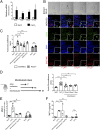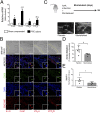Cysteinyl leukotriene receptor 1 antagonism prevents experimental abdominal aortic aneurysm
- PMID: 29432192
- PMCID: PMC5828611
- DOI: 10.1073/pnas.1717906115
Cysteinyl leukotriene receptor 1 antagonism prevents experimental abdominal aortic aneurysm
Abstract
Cysteinyl-leukotrienes (cys-LTs) are 5-lipoxygenase-derived lipid mediators involved in the pathogenesis and progression of inflammatory disorders, in particular asthma. We have previously found evidence linking these mediators to increased levels of proteolytic enzymes in tissue specimens of human abdominal aortic aneurysm (AAA). Here we show that antagonism of the CysLT1 receptor by montelukast, an established antiasthma drug, protects against a strong aorta dilatation (>50% increase = aneurysm) in a mouse model of CaCl2-induced AAA at a dose comparable to human medical practice. Analysis of tissue extracts revealed that montelukast reduces the levels of matrix metalloproteinase-9 (MMP-9) and macrophage inflammatory protein-1α (MIP-1α) in the aortic wall. Furthermore, aneurysm progression was specifically mediated through CysLT1 signaling since a selective CysLT2 antagonist was without effect. A significantly reduced vessel dilatation is also observed when treatment with montelukast is started days after aneurysm induction, suggesting that the drug not only prevents but also stops and possibly reverts an already ongoing degenerative process. Moreover, montelukast reduced the incidence of aortic rupture and attenuated the AAA development in two additional independent models, i.e., angiotensin II- and porcine pancreatic elastase-induced AAA, respectively. Our results indicate that cys-LTs are involved in the pathogenesis of AAA and that antagonism of the CysLT1 receptor is a promising strategy for preventive and therapeutic treatment of this clinically silent and highly lethal disease.
Keywords: abdominal aortic aneurysm; inflammation; leukotriene; montelukast.
Copyright © 2018 the Author(s). Published by PNAS.
Conflict of interest statement
The authors declare no conflict of interest.
Figures




Similar articles
-
Cysteine Leukotriene Receptor Antagonist-Montelukast-Treatment Improves Experimental Abdominal Aortic Aneurysms in Mice.Cardiovasc Ther. 2024 Nov 27;2024:8826287. doi: 10.1155/2024/8826287. eCollection 2024. Cardiovasc Ther. 2024. PMID: 39742015 Free PMC article.
-
Montelukast, a Cysteinyl Leukotriene Receptor 1 Antagonist, Induces M2 Macrophage Polarization and Inhibits Murine Aortic Aneurysm Formation.Biomed Res Int. 2019 May 27;2019:9104680. doi: 10.1155/2019/9104680. eCollection 2019. Biomed Res Int. 2019. PMID: 31263710 Free PMC article.
-
Targeting cysteinyl-leukotrienes in abdominal aortic aneurysm.Prostaglandins Other Lipid Mediat. 2018 Nov;139:24-28. doi: 10.1016/j.prostaglandins.2018.09.007. Epub 2018 Sep 21. Prostaglandins Other Lipid Mediat. 2018. PMID: 30248405 Review.
-
Effects of montelukast, a cysteinyl-leukotriene type 1 receptor antagonist, on the pathogenesis of bleomycin-induced pulmonary fibrosis in mice.Eur J Pharmacol. 2011 Jan 10;650(1):424-30. doi: 10.1016/j.ejphar.2010.09.084. Epub 2010 Oct 27. Eur J Pharmacol. 2011. PMID: 21034736
-
The leukotriene receptor antagonist montelukast and its possible role in the cardiovascular field.Eur J Clin Pharmacol. 2017 Jul;73(7):799-809. doi: 10.1007/s00228-017-2242-2. Epub 2017 Apr 4. Eur J Clin Pharmacol. 2017. PMID: 28374082 Review.
Cited by
-
Montelukast potentiates the antiinflammatory effect of NSAIDs in the rat paw formalin model and simultaneously minimizes the risk of gastric damage.Inflamm Res. 2021 Sep;70(9):981-992. doi: 10.1007/s00011-021-01492-9. Epub 2021 Aug 11. Inflamm Res. 2021. PMID: 34382102
-
Cysteine Leukotriene Receptor Antagonist-Montelukast-Treatment Improves Experimental Abdominal Aortic Aneurysms in Mice.Cardiovasc Ther. 2024 Nov 27;2024:8826287. doi: 10.1155/2024/8826287. eCollection 2024. Cardiovasc Ther. 2024. PMID: 39742015 Free PMC article.
-
Identifying pyroptosis- and inflammation-related genes in intracranial aneurysms based on bioinformatics analysis.Biol Res. 2023 Sep 27;56(1):50. doi: 10.1186/s40659-023-00464-z. Biol Res. 2023. PMID: 37752552 Free PMC article.
-
Montelukast, a Cysteinyl Leukotriene Receptor 1 Antagonist, Induces M2 Macrophage Polarization and Inhibits Murine Aortic Aneurysm Formation.Biomed Res Int. 2019 May 27;2019:9104680. doi: 10.1155/2019/9104680. eCollection 2019. Biomed Res Int. 2019. PMID: 31263710 Free PMC article.
-
Translating mouse models of abdominal aortic aneurysm to the translational needs of vascular surgery.JVS Vasc Sci. 2021 Mar 3;2:219-234. doi: 10.1016/j.jvssci.2021.01.002. eCollection 2021. JVS Vasc Sci. 2021. PMID: 34778850 Free PMC article. Review.
References
-
- Maegdefessel L, Dalman RL, Tsao PS. Pathogenesis of abdominal aortic aneurysms: MicroRNAs, proteases, genetic associations. Annu Rev Med. 2014;65:49–62. - PubMed
-
- Hellenthal FA, Buurman WA, Wodzig WK, Schurink GW. Biomarkers of AAA progression. Part 1: Extracellular matrix degeneration. Nat Rev Cardiol. 2009;6:464–474. - PubMed
-
- Swedenborg J, Eriksson P. The intraluminal thrombus as a source of proteolytic activity. Ann N Y Acad Sci. 2006;1085:133–138. - PubMed
-
- Drazen JM, Israel E, O’Byrne PM. Treatment of asthma with drugs modifying the leukotriene pathway. N Engl J Med. 1999;340:197–206. - PubMed
Publication types
MeSH terms
Substances
LinkOut - more resources
Full Text Sources
Other Literature Sources
Miscellaneous

